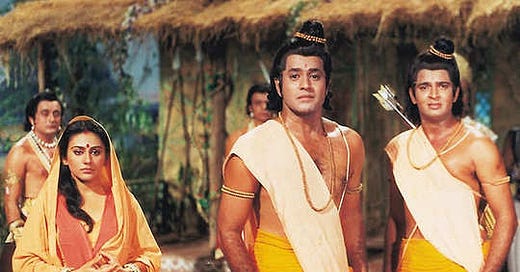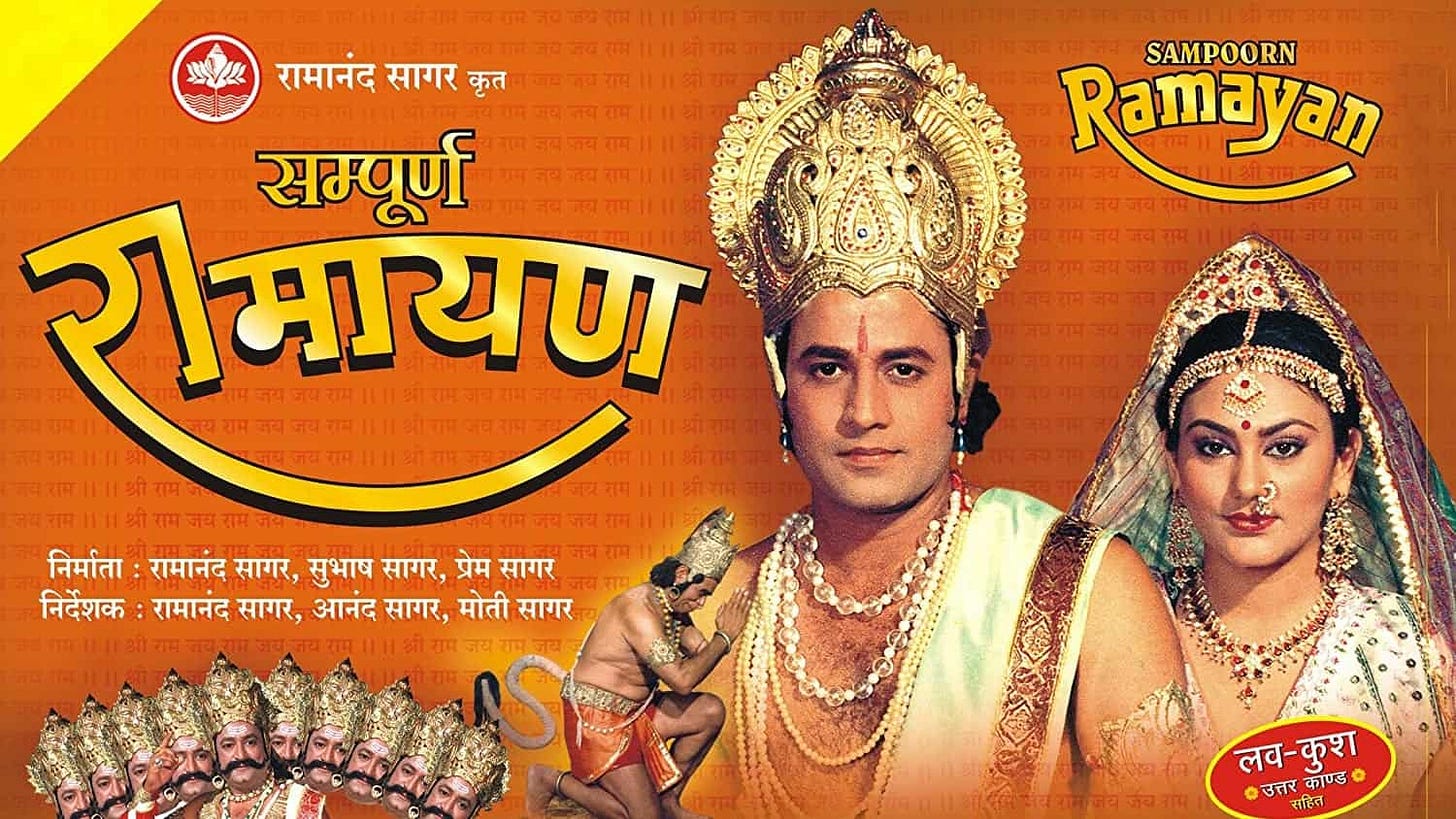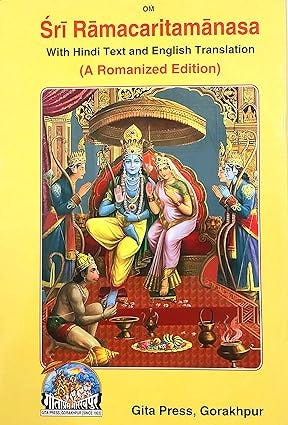"The Ramayana Unveiled: A Timeless Odyssey of Love, Duty, and Divine Justice"
"Exploring the Epic of Ramayana: A Journey through Mythology, Morality, and the Eternal Battle of Good vs. Evil"
Introduction
In the field of ancient Indian literature and mythology, some stories like epics like Ramayana, Mahabharata, etc. continue to resonate deeply in the hearts of Indians and citizens living all over the world.
Classic tales like the Ramayana have fascinated generations with their rich tapestry of morals, values, and deep spiritual teachings. Rooted in the ancient Vedic tradition, the epic Ramayana is a story of love, duty, bravery, and the eternal war between good and evil.
As we embark on this journey into the heart of Indian mythology, we will unravel the epic of the Ramayana, exploring its origins, characters, and enduring significance.
Origin of Ramayana
The Ramayana is attributed to the sage Valmiki, who was a revered figure in Indian culture. Legend has it that Valmiki was inspired to compose this epic after witnessing a poignant scene in nature – a hunter killing one of a pair of birds in love.
Filled with grief and sympathy, Valmiki spontaneously uttered a beautiful poem in poetic verse. This event marked the birth of the Ramayana, and Valmiki is often referred to as Adikavi, the "first poet".
The background of Ramayana is Treta Yuga, one of the four eras of Hindu cosmology. It tells the story of Lord Rama, the seventh incarnation of Lord Vishnu, and his quest to save his beloved wife Sita from the clutches of the demon king Ravana.
The epic is divided into seven kandas (books) that describe the life of Rama from his birth to his return to Ayodhya after his victory over Ravana.
Ramayana in brief
Once upon a time, there lived a prince named Ram in the ancient land of India. He was the eldest son of King Dasharatha and Queen Kausalya and was known far and wide for his intelligence, strength, and unwavering commitment to religion.
Rama's life took a dramatic turn when his father decided to make him heir to the throne of Ayodhya. But on the eve of Rama's coronation, Queen Kaikeyi, one of King Dasharatha's wives, made a terrible demand.
He asked the king to send Ram to exile for fourteen years and make his son Bharat the king in his place. Dasharatha, bound by his promise to Kaikeyi, had no option but to keep it.
Rama accepted his father's decision with grace and humility. He left Ayodhya with his faithful wife, Sita, and his devoted brother, Lakshmana. They started living a life of exile in the dense forests.
In the forest, Rama, Sita, and Lakshmana had to face various challenges and face dangers of the forest. He formed an alliance with the forest dwellers and lived a simple life following his principles of righteousness.
Rama's unwavering devotion to Dharma earned him the admiration and respect of both humans and animals.
However, their peaceful life is disrupted when the demon king Ravana learns of Sita's beauty and abducts her. Rama and Lakshmana are deeply saddened by Sita's disappearance and set out on a dangerous journey to rescue her.
In his quest, he encountered the monkey-god Hanuman, who became his devoted ally. With the aid of Hanuman and a mighty army of monkeys, he waged war against the demonic army of Ravana. After a fierce battle, Rama defeated Ravana and rescued Sita.
Ram's victory was proof of the victory of good over evil. Along with Sita, he returned to Ayodhya after completing fourteen years of exile.
The people of Ayodhya rejoiced at his return and Rama was crowned as the rightful king, fulfilling his destiny.
Rama's reign was marked by peace, prosperity, and justice. His life exemplifies the values of righteousness, duty, and unwavering dedication to truth.
The epic Ramayana serves as an enduring source of inspiration, reminding us of the eternal lessons of love, loyalty, duty, and the ultimate victory of good over evil.
Major characters of Ramayana
Every character of Ramayana has a special role, all the characters make a place in the hearts because of their sacrifice and courage to follow their religion. Nevertheless, let us briefly discuss some special characters,
Lord Rama: The central character of Ramayana, Rama is the epitome of virtue, righteousness, and religion. He is the eldest son of King Dasharatha and Queen Kausalya.
Rama's unwavering commitment to fulfilling his duties as a son, husband, and warrior prince makes him an enduring symbol of moral excellence. Those who believe in Ramayana still consider Ram as their king. Ram has become a source of inspiration for people for his dignity, adherence to religion, devotion to duty, and truth.
Sita: Sita, daughter of King Janak, is a symbol of grace, beauty, and devotion. Her unwavering loyalty to Rama, even during abduction and captivity, makes her an iconic symbol of husband-wife devotion.
Sita's marriage with Ram took place in Swayamvara, which was as per the condition of King Janak to break Shiva's bow.
Lakshmana: Rama's younger brother, Lakshmana, is an example of loyalty and selflessness. He accompanied Rama into exile and served him devotedly during the years he spent in the forest.
During the war with Ravana, Lakshman killed Ravana's eldest son Meghnad (Indrajit).
Hanuman: The monkey-god Hanuman is one of the most beloved characters of the Ramayana. His immense strength, intelligence, and unwavering devotion towards Lord Rama played a vital role in the protection of Sita and the defeat of Ravana.
Ravana: The demon king Ravana is the primary antagonist of the epic. He is portrayed as a complex character with immense knowledge and power, but his arrogance and ego ultimately lead to his downfall.
Vibhishana: Ravana's brother, Vibhishana, sides with Rama, providing valuable insight and assistance in the fight against his own relatives. His character shows the importance of choosing the path of religion.
Incidents from Ramayana
Ramayana explores a number of themes that continue to resonate with audiences today:
Dharma (righteousness): The epic emphasizes the importance of maintaining one's duty and righteousness even in adverse circumstances.
Love and devotion: The undying love between Rama and Sita, as well as Hanuman's devotion to Rama, shows the profound depth of love and devotion.
Good vs Evil: The war between Rama and Ravana symbolizes the eternal struggle between good and evil, in which good ultimately wins.
Leadership and Sacrifice: Rama's selfless sacrifice and his qualities as a leader make him a role model for kings and leaders throughout history.
Loyalty and brotherhood: The bond between Rama and his brothers, especially Lakshmana, exemplifies the importance of familial and brotherly loyalty.
Female Strength: Sita's resilience and strength in the face of adversity challenge traditional gender roles and celebrate female strength.
Permanent importance of Ramayana
Ramayana has transcended time and space to become a universal epic. Its teachings and stories have influenced art, culture, and philosophy not only in India but throughout Southeast Asia. Here are some of the reasons for its enduring importance:
Moral and ethical guidance: Ramayana provides a moral guideline, which guides individuals on the path of righteousness, integrity, and duty.
Cultural Identity: The epic is a foundational text in Hindu culture, serving as a source of cultural pride and identity.
Artistic Expression: The Ramayana has inspired countless artistic endeavors, from classical dance and music to visual arts and theatre.
Interreligious Appeal: Its themes of love, sacrifice, and virtue resonate with people from diverse religious and cultural backgrounds.
Philosophical Explorations: Ramayana throws light on deep philosophical questions like the nature of good and evil, the concept of dharma, and the purpose of life.
Socio-political impact: The epic has shaped political thought and governance, emphasizing the role of leaders as protectors of religion and the welfare of their subjects.
Resources
Ramayana, apart from being a mythological epic, also gives courage to face many challenges of today's life. The answer to how one should live with devotion to duty is clearly found in Ramayana. If in today's technological era, you want to know the secrets of Ramayana, there are some resources that will satisfy your curiosity.
Ramanand Sagar Ramayana(Hindi)
The Ramayana serial was started by the famous director Ramanand Sagar in the decade 80, It is considered to be the best serial made on Ramayana to date.
It is said that when Ramayana was telecast in the 80's, the entire city, market, and streets would become silent. Not only Hindus, but also Sikhs, Muslims, Bodhs, and Jains used to spare time and watch this creation of religion, leaving aside their work.
This composition is available for free on YouTube today. You can watch this epic by clicking on this link.
Ramcharitmanas – This poem written by Saint Mahakavi Tulsidas presents the biography of Ram in the form of literary art. It is in Adi language and its translated copy can be bought online.
Valmiki Ramayana – This is the most popular book of Ramayana and can be found translated into almost every language. You can buy it through this link.
Conclusion
The Ramayana, with its timeless themes and characters, remains a gem in world literature and mythology. Its enduring importance lies not only in its ability to entertain but also to inspire, instruct, and uplift the human spirit.
As we journey through the pages of this epic, we gain insight into the complexities of human nature and the eternal search for truth, righteousness, and love – themes that continue to resonate with us even today.
Ramayana is more than just a story; It is a profound reflection of the human experience, a guide to virtuous living, and a testament to the enduring power of myth and storytelling.
We will also discuss other things related to the characters of Ramayana in the next edition, but now in the next edition, we will discuss Mahabharata, the second epic of Hindu mythology.
How did you like this edition, if you have any comments, questions, or ideas, please let us know. And if you liked this edition, then please give your opinion, like, and share it with your friends and family. And stay with us. Thank you







